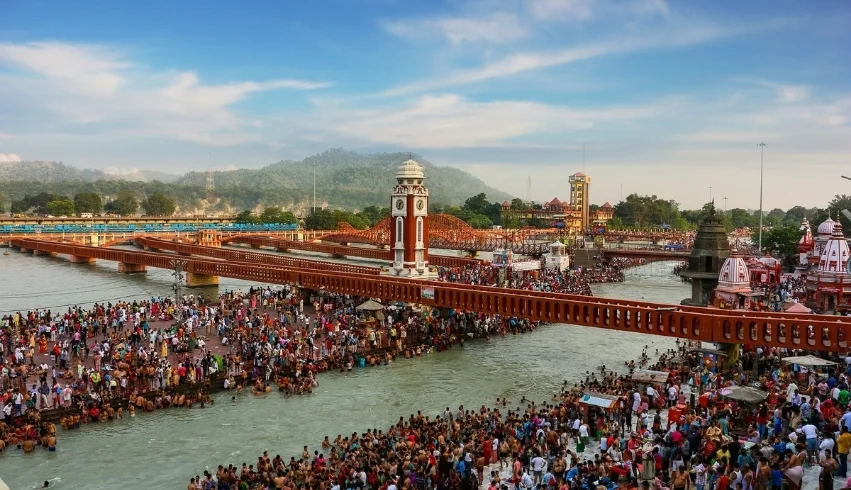
Mythological roots
The history of Haridwar is steeped in Hindu mythology. According to legends, it is one of the four sites where drops of Amrit (nectar of immortality) fell from the divine pitcher carried by Garuda during the Samudra manthan. This event gave rise to the Kumbh Mela, held every 12 years, which is visited by millions of pilgrims from all over the world.
The city is also associated with many ancient sages and deities. It is believed that Lord Vishnu left his footprint on a stone at Har Ki Pauri, and this place is revered as the holiest part of the city. The Vedic philosopher Sage Kapila is said to have meditated in Haridwar, and the city is mentioned in ancient texts such as the Mahabharata and various Puranas.
Medieval and modern history
During the medieval period, Haridwar was known as Maya Puri, one of the seven sacred Sapta Puris in Hinduism. The city was a centre of education and spiritual development. Haridwar was under the control of various dynasties, including the Mauryas and later the Mughals, who contributed to its architecture and infrastructure.
Under British rule, Haridwar became part of the United Provinces and rail and road networks developed. The British also recognised the spiritual significance of the city and facilitated the organisation of pilgrimages and religious fairs.
Important Factors of Haridwar
- Religious Importance
Haridwar is considered one of the seven holiest cities (Sapta Puri) in Hinduism. It is a major site for rituals such as Pind Daan, Asthi Visarjan (immersion of ashes) and Shradh ceremonies.
The city is a starting point for the Char Dham Yatra and hosts major pilgrimages such as the Kumbh Mela, Ardh Kumbh and the Kanwar Yatra, which attract millions of devotees from across the world.
- Spiritual Factors
Haridwar’s spiritual aura goes beyond religious rituals. It is a place where seekers come to meditate, contemplate and attain higher consciousness. Here are some of the key spiritual aspects:
Har Ki Pauri: More than a ghat, it is considered the spiritual heart of Haridwar. The daily Ganga Aarti is a soul-stirring experience where devotees gather at sunset to offer fire, chants and hymns to the river goddess Ganga.
Ashrams and Saints: Haridwar has many ashrams, including Shantikunj, Patanjali Yogpeeth and Parmarth Ashram, which guide seekers on spiritual topics such as yoga, meditation and Vedanta.
Vibrating Energy: Collective faith, centuries-old sadhana (spiritual practice) and the presence of the holy Ganga create an energetic field conducive to inner transformation and peace.
Spiritual Teachings: Sermons of saints, kirtans, satsangs and Vedic teachings make Haridwar a living university of spiritual knowledge.
Peace and Solitude: Despite its crowds, many parts of Haridwar offer quiet spaces that are perfect for meditation and self-inquiry.
- Cultural and Educational Hubs
Haridwar has long been a centre for Vedic education and Sanskrit learning. Institutions such as the Gurukul Kangri University were established to promote traditional education and preserve Indian culture. The city remains a hub of scholars, saints, and spiritual seekers. - Environmental and Geographical Importance
Located on the banks of the Ganges River, Haridwar is the point where the river leaves the Himalayas and enters the Indo-Gangetic plains. The Ganges here is considered particularly pure and sacred. Efforts have been made in recent decades to maintain its ecological balance through various Ganga clean-up campaigns.
- Tourism and Economy
Religious tourism is the backbone of Haridwar’s economy. The city is dotted with temples, ashrams, and dharamshalas that serve visitors. Popular temples include the Mansa Devi Temple, Chandi Devi Temple, Bharat Mata Temple, and Daksha Mahadev Temple.
Apart from religious tourism, the city also promotes wellness tourism with several Ayurvedic and yoga centers, reflecting India’s ancient health systems.
- Industrial and Infrastructural Development
Apart from its religious aspect, Haridwar has witnessed considerable industrial development. The establishment of SIDCUL (Uttarakhand State Infrastructure and Industrial Development Corporation Limited) has attracted major industries like BHEL (Bharat Heavy Electricals Limited), which has contributed to the economic growth of the region.
Conclusion
Haridwar is a living illustration of India’s spiritual essence, historical depth, and cultural heritage. As a city that bridges the ancient and the modern, it continues to inspire pilgrims, travelers, and thinkers alike. Whether through the chants resonating on the ghats, the fragrance of incense in the temples, or the call for ecological conservation, Haridwar stands as a symbol of India’s timeless journey through faith, devotion, and progress.
